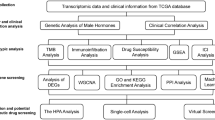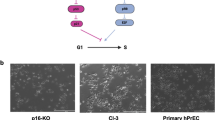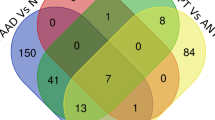Abstract
Prostate cancer is the most common cancer in men of the western world. To date, no effective treatment exists for metastatic prostate cancer and consequently, there is an urgent need to develop new and improved therapeutics. In recent years, the therapeutic potential of RNA interference (RNAi) has been extensively explored in a wide range of diseases including prostate cancer using numerous gene delivery vectors. The aims of this study were to investigate the ability of a non-viral modified cyclodextrin (CD) vector to deliver siRNA to the highly metastatic PC-3 prostate cancer cell line, to quantify the resulting knockdown of the two target genes (RelA and SRF) and to study the effects of the silencing on metastasis. Data from a Matrigel in vitro invasion assay indicated that the silencing of the target genes achieved by the CD vector resulted in significant reductions (P=0.0001) in the metastatic potential of these cells. As the silencing of these target genes was shown not to have a negative impact on cell viability, we hypothesise that the mechanism of invasion inhibition is due, in part, to the significant reduction observed (P⩽0.0001) in the level of pro-inflammatory cytokine, MMP9, which is known to be implicated in the metastasis of prostate cancer.
This is a preview of subscription content, access via your institution
Access options
Subscribe to this journal
Receive 6 print issues and online access
$259.00 per year
only $43.17 per issue
Buy this article
- Purchase on SpringerLink
- Instant access to full article PDF
Prices may be subject to local taxes which are calculated during checkout






Similar content being viewed by others
References
Marin-Aguilera M, Codony-Servat J, Kalko SG, Fernandez PL, Bermudo R, Buxo E et al. Identification of docetaxel resistance genes in castration-resistant prostate cancer. Mol Cancer Therapeut 2012; 11: 329–339.
Mohan R, Schellhammer PF . Treatment options for localized prostate cancer. Am Fam Physician 2011; 84: 413–420.
Seruga B, Ocana A, Tannock IF . Drug resistance in metastatic castration-resistant prostate cancer. Nat Rev Clin Oncol 2011; 8: 12–23.
Shafi AA, Yen AE, Weigel NL . Androgen receptors in hormone-dependent and castration-resistant prostate cancer. Pharmacol Therapeut 2013; 140: 223–238.
Yin L, Hu Q, Hartmann RW . Recent progress in pharmaceutical therapies for castration-resistant prostate cancer. Int J Mol Sci 2013; 14: 13958–13978.
O'Neill AJ, Prencipe M, Dowling C, Fan Y, Mulrane L, Gallagher WM et al. Characterisation and manipulation of docetaxel resistant prostate cancer cell lines. Mol Cancer 2011; 10: 126.
Fire A, Xu S, Montgomery MK, Kostas SA, Driver SE, Mello CC . Potent and specific genetic interference by double-stranded RNA in Caenorhabditis elegans. Nature 1998; 391: 806–811.
Guo J, Evans JC, O'Driscoll CM . Delivering RNAi therapeutics with non-viral technology: a promising strategy for prostate cancer? Trends Mol Med 2013; 19: 250–261.
Davis ME, Zuckerman JE, Choi CH, Seligson D, Tolcher A, Alabi CA et al. Evidence of RNAi in humans from systemically administered siRNA via targeted nanoparticles. Nature 2010; 464: 1067–1070.
McCarthy J, O'Neill MJ, Bourre L, Walsh D, Quinlan A, Hurley G et al. Gene silencing of TNF-alpha in a murine model of acute colitis using a modified cyclodextrin delivery system. J Controlled Release 2013; 168: 28–34.
Godinho BM, Ogier JR, Darcy R, O'Driscoll CM, Cryan JF . Self-assembling modified beta-cyclodextrin nanoparticles as neuronal siRNA delivery vectors: focus on Huntington's disease. Mol Pharm 2013; 10: 640–649.
Guo J, Ogier JR, Desgranges S, Darcy R, O'Driscoll C . Anisamide-targeted cyclodextrin nanoparticles for siRNA delivery to prostate tumours in mice. Biomaterials 2012; 33: 7775–7784.
Prencipe M, Madden SF, O'Neill A, O'Hurley G, Culhane A, O'Connor D et al. Identification of transcription factors associated with castration-resistance: is the serum responsive factor a potential therapeutic target? Prostate 2013; 73: 743–753.
Chai J, Tarnawski AS . Serum response factor: discovery, biochemistry, biological roles and implications for tissue injury healing. J Physiol Pharmacol 2002; 53: 147–157.
Posern G, Treisman R . Actin’ together: serum response factor, its cofactors and the link to signal transduction. Trends Cell Biol 2006; 16: 588–596.
Heemers HV, Regan KM, Dehm SM, Tindall DJ . Androgen induction of the androgen receptor coactivator four and a half LIM domain protein-2: evidence for a role for serum response factor in prostate cancer. Cancer Res 2007; 67: 10592–10599.
Yu W, Feng S, Dakhova O, Creighton CJ, Cai Y, Wang J et al. FGFR-4 Arg(3)(8)(8) enhances prostate cancer progression via extracellular signal-related kinase and serum response factor signaling. Clin Cancer Res 2011; 17: 4355–4366.
Jain G, Cronauer MV, Schrader M, Moller P, Marienfeld RB . NF-kappaB signaling in prostate cancer: a promising therapeutic target? World J Urol 2012; 30: 303–310.
Zubair A, Frieri M . Role of nuclear factor-kB in breast and colorectal cancer. Curr Allergy Asthma Rep 2013; 13: 44–49.
Lessard L, Karakiewicz PI, Bellon-Gagnon P, Alam-Fahmy M, Ismail HA, Mes-Masson AM et al. Nuclear localization of nuclear factor-kappaB p65 in primary prostate tumors is highly predictive of pelvic lymph node metastases. Clin Cancer Res 2006; 12: 5741–5745.
Huang S, Pettaway CA, Uehara H, Bucana CD, Fidler IJ . Blockade of NF-kappaB activity in human prostate cancer cells is associated with suppression of angiogenesis, invasion, and metastasis. Oncogene 2001; 20: 4188–4197.
Xu L, Wang Z, Li X-F, He X, Guan L-L, Tuo J-L et al. Screening and identification of significant genes related to tumor metastasis and PSMA in prostate cancer using microarray analysis. Oncol Rep 2013; 30: 1920–1928.
Clarke NW, Hart CA, Brown MD . Molecular mechanisms of metastasis in prostate cancer. Asian J Androl 2009; 11: 57–67.
Yao D, Dai C, Peng S . Mechanism of the mesenchymal–epithelial transition and its relationship with metastatic tumor formation. Mol Cancer Res 2011; 9: 1608–1620.
Wells A, Yates C, Shepard CR . E-cadherin as an indicator of mesenchymal to epithelial reverting transitions during the metastatic seeding of disseminated carcinomas. Clin Exp Metastasis 2008; 25: 621–628.
Taddei ML, Giannoni E, Comito G, Chiarugi P . Microenvironment and tumor cell plasticity: An easy way out. Cancer Lett 2013; 341: 80–96.
Yadav L, Puri N, Rastogi V, Satpute P, Ahmad R, Kaur G . Matrix metalloproteinases and cancer-roles in threat and therapy. Asian Pac J Cancer Prev 2014; 15: 1085–1091.
O’Mahony AM, Godinho BMDC, Ogier J, Devocelle M, Darcy R, Cryan JF et al. Click-modified cyclodextrins as nonviral vectors for neuronal siRNA delivery. ACS Chem Neurosci 2012; 3: 744–752.
Pulukuri SM, Rao JS . Matrix metalloproteinase-1 promotes prostate tumor growth and metastasis. Int J Oncol 2008; 32: 757–765.
Davis ME, Zuckerman JE, Choi CHJ, Seligson D, Tolcher A, Alabi CA et al. Evidence of RNAi in humans from systemically administered siRNA via targeted nanoparticles. Nature 2010; 464: 1067–1070.
Zhou Y, Zhang C, Liang W . Development of RNAi technology for targeted therapy—a track of siRNA based agents to RNAi therapeutics. J Controlled Release 2014; 193: 270–281.
O'Mahony AM, O'Neill MJ, Godinho BMDC, Darcy R, Cryan JF, O'Driscoll CM . Cyclodextrins for non-viral gene and siRNA delivery. Pharmaceut Nanotechnol 2013; 1: 6–14.
Fitzgerald KA, Evans JC, McCarthy J, Guo J, Prencipe M, Kearney M et al. The role of transcription factors in prostate cancer and potential for future RNA interference therapy. Expert Opin Therapeut Targets 2014; 18: 633–649.
Santel A, Aleku M, Keil O, Endruschat J, Esche V, Durieux B et al. RNA interference in the mouse vascular endothelium by systemic administration of siRNA-lipoplexes for cancer therapy. Gene Therapy 2006; 13: 1360–1370.
Aleku M, Schulz P, Keil O, Santel A, Schaeper U, Dieckhoff B et al. Atu027, a liposomal small interfering RNA formulation targeting protein kinase N3, inhibits cancer progression. Cancer Res 2008; 68: 9788–9798.
Takeshita F, Minakuchi Y, Nagahara S, Honma K, Sasaki H, Hirai K et al. Efficient delivery of small interfering RNA to bone-metastatic tumors by using atelocollagen in vivo. Proc Natl Acad Sci USA 2005; 102: 12177–12182.
O'Hurley G, Prencipe M, Lundon D, O'Neill A, Boyce S, O'Grady A et al. The analysis of serum response factor expression in bone and soft tissue prostate cancer metastases. Prostate 2014; 74: 306–313.
Bell JL, Haak AJ, Wade SM, Kirchhoff PD, Neubig RR, Larsen SD . Optimization of novel nipecotic bis(amide) inhibitors of the Rho/MKL1/SRF transcriptional pathway as potential anti-metastasis agents. Bioorg Med Chem Lett 2013; 23: 3826–3832.
Hour MJ Tsai SC, Wu HC, Lin MW, Chung JG, Wu JB et al. Antitumor effects of the novel quinazolinone MJ-33: inhibition of metastasis through the MAPK, AKT, NF-kappaB and AP-1 signaling pathways in DU145 human prostate cancer cells. Int J Oncol 2012; 41: 1513–1519.
Zou Z, Zeng F, Xu W, Wang C, Ke Z, Wang QJ et al. PKD2 and PKD3 promote prostate cancer cell invasion by modulating NF-kappaB- and HDAC1-mediated expression and activation of uPA. J Cell Sci 2012; 125: 4800–4811.
O'Mahony AM, Desgranges S, Ogier J, Quinlan A, Devocelle M, Darcy R et al. In vitro investigations of the efficacy of cyclodextrin-siRNA complexes modified with lipid-PEG-Octaarginine: towards a formulation strategy for non-viral neuronal siRNA delivery. Pharmaceut Res 2013; 30: 1086–1098.
O'Mahony AM, Ogier J, Desgranges S, Cryan JF, Darcy R, O'Driscoll CM . A click chemistry route to 2-functionalised PEGylated and cationic beta-cyclodextrins: co-formulation opportunities for siRNA delivery. Org Biomol Chem 2012; 10: 4954–4960.
Pietschke K, Walker T, Krajewski S, Kurz J, Aufderklamm S, Schwentner C et al. The chance of small interfering RNAs as eligible candidates for a personalized treatment of prostate cancer. Curr Pharmaceut Biotechnol 2014; 14: 1145–1154.
Ge R, Wang Z, Zeng Q, Xu X, Olumi AF . F-box protein 10, an NF-kappaB-dependent anti-apoptotic protein, regulates TRAIL-induced apoptosis through modulating c-Fos/c-FLIP pathway. Cell Death Differ 2011; 18: 1184–1195.
Banerjee S, Kong D, Azmi AS, Wang Z, Ahmad A, Sethi S et al. Restoring sensitivity to oxaliplatin by a novel approach in gemcitabine-resistant pancreatic cancer cells in vitro and in vivo. Int J Cancer 2011; 128: 1240–1250.
Shuman Moss LA, Jensen-Taubman S, Stetler-Stevenson WG . Matrix metalloproteinases: changing roles in tumor progression and metastasis. Am J Pathol 2012; 181: 1895–1899.
Fiorentini C, Bodei S, Bedussi F, Fragni M, Bonini SA, Simeone C et al. GPNMB/OA protein increases the invasiveness of human metastatic prostate cancer cell lines DU145 and PC3 through MMP-2 and MMP-9 activity. Exp Cell Res 2014; 323: 100–111.
Ellem SJ, De-Juan-Pardo EM, Risbridger GP . In vitro modeling of the prostate cancer microenvironment. Adv Drug Deliv Rev 2014; 79-80: 214–221.
Hu S, Li L, Yeh S, Cui Y, Li X, Chang H-C et al. Infiltrating T cells promote prostate cancer metastasis via modulation of FGF11→miRNA-541→androgen receptor (AR)→MMP9 signaling. Mol Oncol 2014; 9: 44–57.
Bedolla RG, Wang Y, Asuncion A, Chamie K, Siddiqui S, Mudryj MM et al. Nuclear versus cytoplasmic localization of filamin A in prostate cancer: immunohistochemical correlation with metastases. Clin Cancer Res 2009; 15: 788–796.
Sun GG, Lu YF, Zhang J, Hu WN . Filamin A regulates MMP-9 expression and suppresses prostate cancer cell migration and invasion. Tumour Biol 2014; 35: 3819–3826.
Desai B, Rogers MJ, Chellaiah MA . Mechanisms of osteopontin and CD44 as metastatic principles in prostate cancer cells. Mol Cancer 2007; 6: 18.
Gupta A, Cao W, Sadashivaiah K, Chen W, Schneider A, Chellaiah MA . Promising noninvasive cellular phenotype in prostate cancer cells knockdown of matrix metalloproteinase 9. ScientificWorldJournal 2013; 2013: 493689.
Morgia G, Falsaperla M, Malaponte G, Madonia M, Indelicato M, Travali S et al. Matrix metalloproteinases as diagnostic (MMP-13) and prognostic (MMP-2, MMP-9) markers of prostate cancer. Urol Res 2005; 33: 44–50.
Aalinkeel R, Nair BB, Reynolds JL, Sykes DE, Mahajan SD, Chadha KC et al. Overexpression of MMP-9 contributes to invasiveness of prostate cancer cell line LNCaP. Immunol Invest 2011; 40: 447–464.
Hoesel B, Schmid JA . The complexity of NF-kappaB signaling in inflammation and cancer. Mol Cancer 2013; 12: 86.
Hoffmann A, Baltimore D . Circuitry of nuclear factor kappaB signaling. Immunol Rev 2006; 210: 171–186.
Paule B, Terry S, Kheuang L, Soyeux P, Vacherot F, de la Taille A . The NF-kappaB/IL-6 pathway in metastatic androgen-independent prostate cancer: new therapeutic approaches? World J Urol 2007; 25: 477–489.
Zarubin T, Han J . Activation and signaling of the p38 MAP kinase pathway. Cell Res 2005; 15: 11–18.
Kuzniewska B, Rejmak E, Malik AR, Jaworski J, Kaczmarek L, Kalita K . Brain-derived neurotrophic factor induces matrix metalloproteinase 9 expression in neurons via the serum response factor/c-Fos pathway. Mol Cell Biol 2013; 33: 2149–2162.
Johansen FE, Prywes R . Two pathways for serum regulation of the c-fos serum response element require specific sequence elements and a minimal domain of serum response factor. Mol Cell Biol 1994; 14: 5920–5928.
Bond M, Chase AJ, Baker AH, Newby AC . Inhibition of transcription factor NF-kappaB reduces matrix metalloproteinase-1, -3 and -9 production by vascular smooth muscle cells. Cardiovasc Res 2001; 50: 556–565.
Scoditti E, Nestola A, Massaro M, Calabriso N, Storelli C, De Caterina R et al. Hydroxytyrosol suppresses MMP-9 and COX-2 activity and expression in activated human monocytes via PKCα and PKCβ1 inhibition. Atherosclerosis 232: 17–24.
Lee YD, Cui MN, Yoon HH, Kim HY, Oh IH, Lee JH . Down-modulation of Bis reduces the invasive ability of glioma cells induced by TPA, through NF-kappaB mediated activation of MMP-9. BMB Rep 2014; 47: 262–267.
Bera A, Zhao S, Cao L, Chiao PJ, Freeman JW . Oncogenic K-Ras and loss of Smad4 mediate invasion by activating an EGFR/NF-kappaB axis that induces expression of MMP9 and uPA in human pancreas progenitor cells. PloS One 2013; 8: e82282.
Kim KR, Bae JS, Choi HN, Park HS, Jang KY, Chung MJ et al. The role of serum response factor in hepatocellular carcinoma: an association with matrix metalloproteinase. Oncol Rep 2011; 26: 1567–1572.
Albini A . Tumor and endothelial cell invasion of basement membranes. The matrigel chemoinvasion assay as a tool for dissecting molecular mechanisms. Pathol Oncol Res 1998; 4: 230–241.
Kleinman HK, Martin GR . Matrigel: basement membrane matrix with biological activity. Semin Cancer Biol 2005; 15: 378–386.
Albini A, Benelli R, Noonan DM, Brigati C . The ‘chemoinvasion assay’: a tool to study tumor and endothelial cell invasion of basement membranes. Int J Dev Biol 2004; 48: 563–571.
Romijn JC, Verkoelen CF, Schroeder FH . Application of the MTT assay to human prostate cancer cell lines in vitro: establishment of test conditions and assessment of hormone-stimulated growth and drug-induced cytostatic and cytotoxic effects. Prostate 1988; 12: 99–110.
Acknowledgements
This work is supported by the Irish Cancer Society via a Research Scholarship to JCE (CRS12EVA) and a Project Grant to COD (PCI11ODR). We thank Bruno Godinho PhD for his technical assistance with the MSD analysis and Meenakshi Malhotra PhD, Amanda O’Neill PhD and Karen Hanrahan MSc for their help with the western blot experiments.
Author information
Authors and Affiliations
Corresponding author
Ethics declarations
Competing interests
The authors declare no conflict of interest.
Additional information
Supplementary Information accompanies this paper on Gene Therapy website
Rights and permissions
About this article
Cite this article
Evans, J., McCarthy, J., Torres-Fuentes, C. et al. Cyclodextrin mediated delivery of NF-κB and SRF siRNA reduces the invasion potential of prostate cancer cells in vitro. Gene Ther 22, 802–810 (2015). https://doi.org/10.1038/gt.2015.50
Received:
Revised:
Accepted:
Published:
Issue date:
DOI: https://doi.org/10.1038/gt.2015.50



